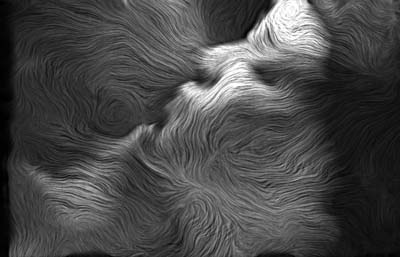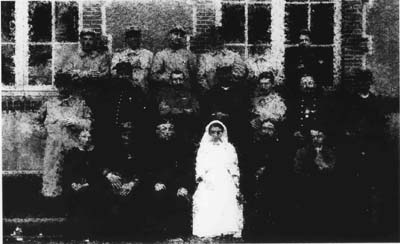The two most popular albums at the iTunes Music Store today are X & Y by Coldplay and Get Behind Me Satan by the White Stripes. To encourage you to make a purchase, the store describes the White Stripes album like this:
The White Stripes unleash their latest album, Get Behind Me Satan, a fiery, brash blast of new music. Recorded in just two weeks at Jack White's Third Man Studios in Detroit, the new record comes with...
Yep, just two weeks. Earthy and raw. And why do the marketing folks think you should also buy the Coldplay album? The blurb for X & Y begins like this:
18 months in the making, the new record from perhaps the most critically acclaimed band in the world is now available.
You see, they've got a little something for everyone.
Echoing some of my own feelings about the San Francisco International Film Festival, Michael Fox has made some great recommendations in the latest SF Weekly. I'm not so sure about his Almodóvar and Hayek examples, but the other ideas are so logical — and yet so counter-intuitive to the prevailing mindset — that I hope the people in charge are paying attention:
In fact, the board needs to take a closer look at the Bay Area, where myriad festivals spotlight every niche and byway of cinema and take a targeted slice of the audience in the bargain. The SFIFF is no longer the only show, as it was 48 years ago, and it's time to reinvent it. Instead of a broad, amorphous catchall of films culled from the festival circuit, it should get smaller and more innovative, scale down the number of movies by a third, and turn more programs into events.For example, fly in Pedro Almodóvar to present the Film Society Directing Award to an aging master — and to introduce three movies from the honoree's oeuvre. Invite Salma Hayek to pick and introduce a couple of new Mexican pictures. Show only documentaries without distribution, and bypass commercial fare such as Mad Hot Ballroom and Murderball. Cut ticket prices for the Skyy Prize contenders — debut narratives by young directors — to $6. (And roll back prices overall, while we're at it.)
There are ways to return the SFIFF to prominence (local, not national) that don't entail going Hollywood or ignoring the marvelous history of cinema. In looking for a new executive director, the board should show the same spine it did when it fired the last one.

Although Chris Marker is one of my favorite filmmakers, my admiration has until recently been based entirely on one feature and one short, Sans Soleil (1983) and La Jetée (1962), respectively. He's made other movies; they're just frustratingly difficult to see. I was glad to read about a retrospective in Helsinki where they'll be showing those two films and handful of others (including Terry Gilliam's 12 Monkeys, which was inspired by La Jetée).
Yeah, great, but I'd be happier if the movies were playing in my neck of the woods. But here's a little something: if you're anywhere near the Museum of Modern Art in New York in the next couple of weeks, stop in and see Marker's latest project, a 19-minute video loop called Owls at Noon.
It's in a museum, you know, so you'll have to ignore the chatter in the gallery next door and the people strolling through your field of vision. The choice of seats is limited to the floor or the wooden bench in the middle of the room, but I have a feeling fans of Marker aren't going to mind.
Owls at Noon is not a single film but a series, what Marker describes as a "subjective journey through the 20th century," beginning with World War I. What's showing at MoMA through June 13 is the first installment, called Prelude: The Hollow Men, a meditation on T.S. Eliot's poem of the same name, written in 1925 in the wake of that war. Marker takes Eliot's evocation of a shapeless, colorless, purposeless existence and applies it to the war's stunned-silent aftermath, the lull and those that came later, as if the 20th century isn't so much defined by its wars but by the brevity of the pauses between them.
The installation consists of two video feeds, sometimes showing the same pictures, other times diverging, one showing a photograph, say, and the other showing text, either an excerpt from the poem or a paragraph of commentary. Although there are only two feeds, they're displayed on a row of eight screens with each feed driving every other screen. The ribbon of alternating pictures on a black wall is most striking when both feeds are showing a photograph but one is slowly zooming in while the other is slowly zooming out. The overall effect is of a single, multi-part, undulating image, like a long banner rippling in the wind.
Marker's commentary is unspoken; it's all on the screen as text. Spacious, ominous ambient piano fills the room — it's Toru Takemitsu's "Corona" — but it seems to fade gradually in volume over the 19 minutes. With its two feeds and multiple, duplicated screens the film strikes a balance between free-form collage and a kind of directed, forward motion. Its pace and purpose are very controlled but Marker allows you to choose where to look. In fact that's not so different from Eliot's poem itself, wildly exercising the freedom to pull lines out of justification, quote from Joseph Conrad's Hearts of Darkness, replicate nursery rhymes, and shoot fireworks for Guy Fawkes, all within a linear structure of five somber stanzas.

Marker's found photos underscore some of the poem's images — when Eliot writes about "eyes I dare not meet in dreams," Marker knows just the sort of eyes he means — but he's not merely illustrating the poem. With a knowledge of 20th century events that Eliot could only dread, Marker shows photo after photo of blank-faced people, hopeless and lost amid war-torn locales. To him, Eliot's "cactus land" and "fading star" might as well be barbed wire fences and military aircraft plunging toward the earth.
Always a lover of language, Marker picks up on the unusual phrases in Eliot's text, repeating "multifoliate rose" if only to highlight its strangeness and commenting on the use of "sightless," which he agrees is much better than "blind," implicitely recalling the title of his own Sans Soleil, which means not "dark" but "sunless." Some of the text in the film is so large that only a couple of letters fit at once; phrases like "HOLLOW MEN" scroll across half the screens so that from time to time the wall is filled with "HO HO HO HO" or "LO LO LO LO" or "ME ME ME ME", the frivilous syllables alternating with images of war.
Lamenting the recurring rhythm of war and the shadowy spaces between, Marker invokes this:
Between the idea
And the reality
Between the motion
And the act
Falls the Shadow
For Thine is the kingdom
That final phrase is like a non-sequitur next to the photos of destruction, or like sarcasm to call a pile of rubble and a people so empty a "kingdom." We love to build, don't we? Even more, we love to tear down, always in the name of what we've built. That's our kingdom. Or rather Thine.
Since the film is being shown as a loop, I'm not sure where it ends and begins, but as Marker nears the end of the poem and the music grows softer, the pictures begin to decay as well. They're treated with subtle digital filters so they look old or fragmented or disintegrated. The more abstract images, like the one at the top of this post, aren't even recognizable as photographs until Marker pulls back a bit and we begin to make out the shapes.

I always like to think that the form of a video installation is somehow tied to the themes of the work, or vice-versa. I know that in most cases a museum probably just commissions this sort of thing for practical reasons — push play and let it run, no need even for a theatre. But like Shakespeare's sonnets, which all follow the exact same structure and still somehow generate a thematic thrust in sync with the dictated meter, a good video installation takes advantage of the looped exhibition.
In Owls at Noon, Marker's undulating, alternating screens, the disintegrating and reintegrating photos, the fading then reappearing musical drone, and, maybe most of all, the faces of weary people frozen the way still cameras freeze people — all of these elements live within the loop, which is woven into the theme, exemplifying Marker's concept of the poem as the prelude to a century of fleeting post-war periods.
This is the way the world ends
This is the way the world ends
This is the way the world ends
Not with a bang but a whimper.
Speaking of New York, I have an online viewing tip: a film that I came across at a small fest in San Francisco last year is now available for download. Nobody Needs to Know surprised me by being more sophisticated than I thought it was going to be at first, and several scenes have stuck with me for a long time. New York-based director Aza Jacobs tells me he put the movie online to let it go — he has since moved on to other projects — but he's had an unexpectedly strong response.
This makes two movies that I know of whose most arresting images involve Tricia Vessey in a bath tub. Trouble Every Day would be the other.
A brief program note. Maybe it is my wont to "suddenly and volcanically" burst forth from time to time, but it's not my want. It's just poor planning.
However, I'm going to post at a more even pace from now on, if I can help it. And clean up my desk. And fix that leak over the garage. I mean it. No, seriously.
I just returned from New York where I saw Chris Marker's latest video installation. More on that later today.